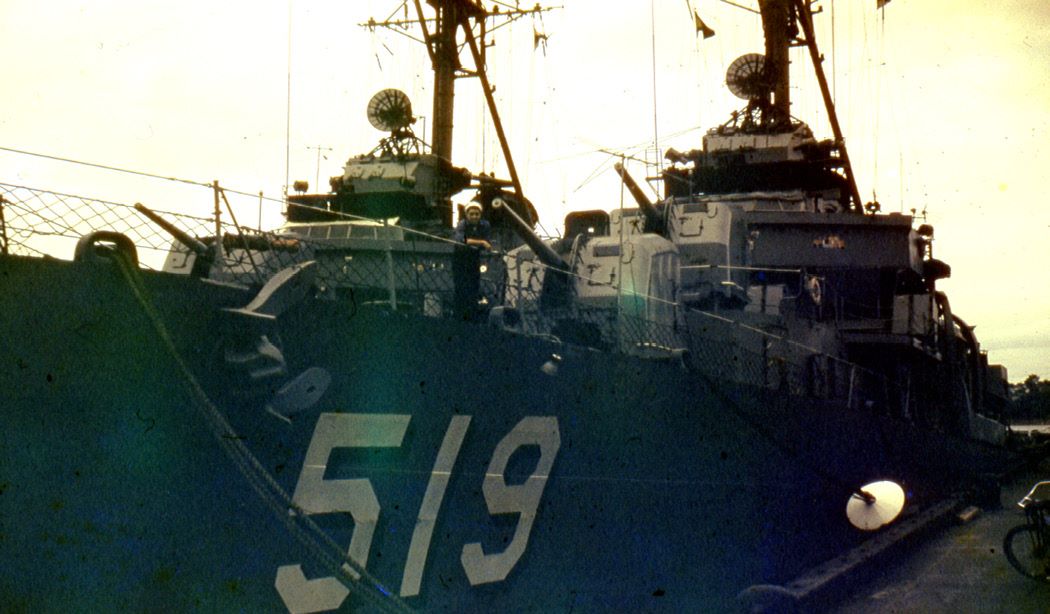

CHAPTER 7:
REPORTING TO MY FIRST SEA DUTY ASSIGNMENT -
THE USS DALY DD-519
NEWPORT, RHODE ISLAND
15 MAY 1955
While I was waiting to receive my orders to the USS DALY, I decided to find out where she was parked, and walked over just to find out exactly where she was moored, because I did not want to be looking for her while carrying a heavy Sea-Bag. She was not in port, but I did find where she usually tied up, at the Destroyer Pier, not too far from the Torpedo School Barracks.
My Sea-Bag and I reported aboard the USS DALY, around mid morning of 15 May 1955, as a designated Torpedoman’s Mate Striker, ( because I had completed Torpedo School Class A ). I was assigned to FOX Division. FOX Division, consisted of Torpedoman, Sonarman and Fire Controlman, and we called the most aft compartment on the ship, HOME!
I soon learned that the USS DALY was a grand old lady; she had the lowest ( Oldest ) Hull Number of any ship of her class in the SIXTH FLEET ( Atlantic Fleet ). She also had a gallant war record, having earned 8 Battle Stars for her participation in Naval Air and Sea engagements during WW II, in the Pacific Theater of Operation. The USS DALY was a major player in an Intense Naval Engagement against forces from the Empire of Japan off the Island of LEYTE in the Philippine Island Group on 24 October 1944. The Naval Engagement later became known as "THE BATTLE OF SURIGAO STRAIT."
I also learned that the USSDALY, was the Flagship of DESTROYER DIVISION ( DESDIV ) 302, which consisted of the USS DALY DD 519, USS SMALLEY DD 565, USS BRONSON DD 668 AND USS COTTENDD 669. All Fletcher Class "CANS" ( Destroyers )
At the time I was aboard the Grand Old Lady, her crews compliment was 250. She had been updated and her main armament consisted of only four 5"38 and all the small caliber AA guns had been replaced by three Twin 3"/50 Rapid Fire AA Guns. Two HEDGEHOG Mounts (ASW Ahead Throw Weapon System ) were mounted aft of Gun Mount 52, No 2 5" 38 on the 01 deck (First deck above the main deck). Only one quintuple Torpedo Tube Mount remained and it was my main work station. As well as two ( Port and Starboard ) Depth Charge Stern Release Racks. Three Depth Charge K-Guns, Port and Starboard. In time, as I learned and advanced in rate, I became responsible for the maintenance and firing of the entire torpedo weapon systems (surface ship and ASW), we acquired the MK-32 Acoustic Homing ASW Torpedo Weapon System. I was also responsible for the maintenance, service, arming, firing / launching of all ASW weapon systems on the DALY.
A LITTLE HISTORIC INFORMATION ON THE USS DALY IS IN ORDER HERE
The USS Daly DD 519, is a 2050 Ton FletcherClass Destroyer ( Normally known as a 2100 Class), she was built and launch by the Bethlehem Steel Company, Staten Island, New York, on 24 October 1942. She was Commissioned as a new ship of the line into the US NAVY on 10 March 1943.
` She was 376 feet 5 inches long, has a beam (width) of 39 feet 7 inches and a draft at 13 feet 9 inches (Keel Depth). The DALY had a top speed (Flank / full) of 38 knots (44 MPH) loaded and ready for battle. Power plant, 60,000 SHP (Ship Horse Power), 2 General Electric Steam (600 LB low pressure steam) Gear Turbines, 4 boilers, twin screws (propellers) and twin rudders. She had a range of 6500 NM (Nautical Miles) at 15 Knots. Her war time crews complement consisted of 273 Officers, Chief Petty Officers and White-Hats (enlisted).
Her main armament ( WW II configuration ) consisted of five 5"38 Gun Mounts and two Quintuple ( 5 torpedo tubes ) MK- 15 Torpedo Tube Mounts. She also had two Depth Charge racks located on her stern and three K-Guns port and starboard, capable of throwing a 300 LB depth charge about 50 yards from the ship on each side, used in Anti- Submarine Warfare ( ASW ). She also had an assortment of small caliber AA ( Anti- Aircraft ) guns, four 1.1", and four 20MM Guns Tubs.
WHAT IS IN THE NAME
US Destroyers, are named after military service members ( Navy and Marine ). The USS DALY was named in honor of Sergeant Major Daniel Daly, USMC. Sergeant Daly serve in the United States Marine Corps from 1899 to 1927. Even though the Daly was named in Honor of US Marine Sergeant Major Daniel Daly, sailors always refer to their ships in the Female Gender.
Among the decorations he received for his heroic and gallant service to his country, he was awarded the most prestigious medal any person serving in the US Military can hope to receive, THE CONGRESSIONAL MEDAL OF HONOR, not once, but on two separate occasions. He also received the Army Distinguish Service Cross, the Navy Cross, Croix de Guerre (with palms), the French Victory Medal and the French Médaille Militaire.
WHAT IS IN THE NAME "TIN CAN SAILOR"
Destroyer men, are sailors that serve on the wettest, roughest riding, deep blue water (Ocean) "MAN - OF – WAR" in the US NAVY and they are a proud lot. They truly can be described as "Old Salts," because when underway in heavy sea conditions, they are constantly being drenched with sea water and salt spray.
They have several Nick Names you often hear when they refer to their ships. They are affectionately called, GREYHOUNDS (due to their speed and low sleek appearance), and TIN CANS, which most SWABBIES (Sailors) shorten to "CANS" -- TIN CANS. CANS, is the most commonly used term by Blue Jackets (Enlisted Sailors) Navy wide, when talking about destroyers. The name, stems from the fact that destroyers are light (thin skin) compared to other larger combatant ships and bounce around a great deal when underway in rough sea conditions. Much like a Tin Can does when thrown into the sea. I can tell you, that I am very proud and honored to have earned the privilege to answer to the name "TIN CAN SAILOR." The Capital Ship NAVY, ( AIRCRAFT CARRIERS, BATTLESHIPS ETC ) refer to Destroyers, (Tin Cans)as the "LITTLE BOYS."

The first pictures I found, that a shipmate took of me leaning on the port bow life line ( above 519 ) aboard the USS Daly, with my camera. My new home away from home. In our Home Port, Newport, Rhode Island May 1955. The bright disk object in photo, is a rat guard on the lines.
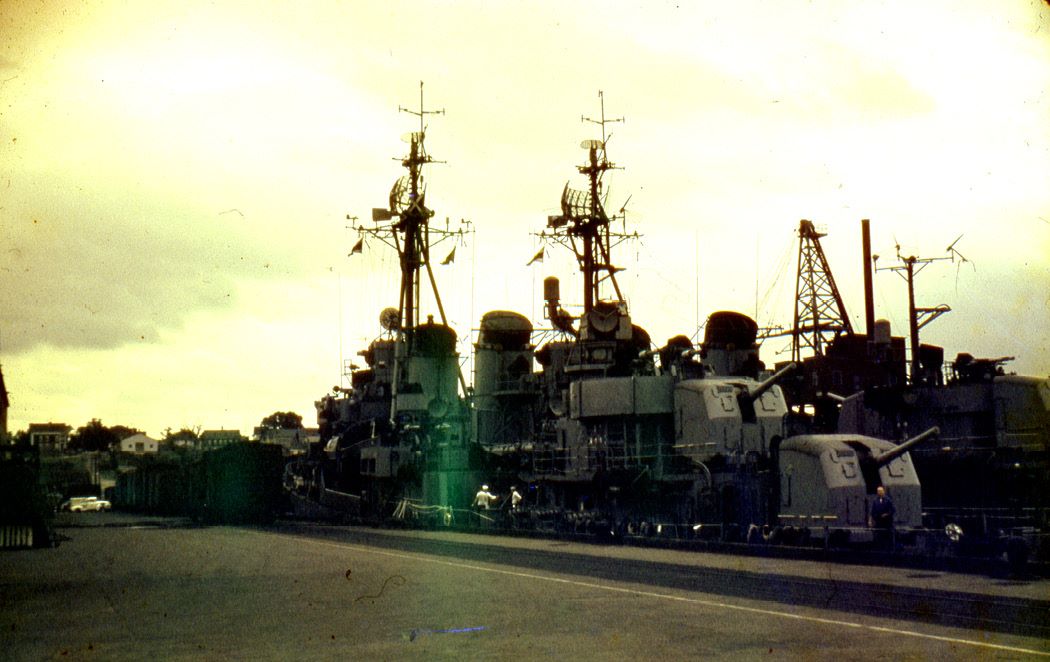
The USS Daly tied up to the old Destroyer Pier in Newport, Rhode Island, May 1955. The Daly shipmate seen standing on the fantail by the after 5" gun mount ( MT 54 ) looking at me, is the same sailor that is holding the flag in the following photo.

A Daly shipmate, standing on top of the stern Port Depth Charge Release Rack, holding Old Glory out so I could capture a good image of it, Newport,R.I. May 1955. The National Ensign ( Navy term for the American flag) is flown from the stern flag staff only while in port, while underway at sea, the Ensign, is flown from the ships mast.
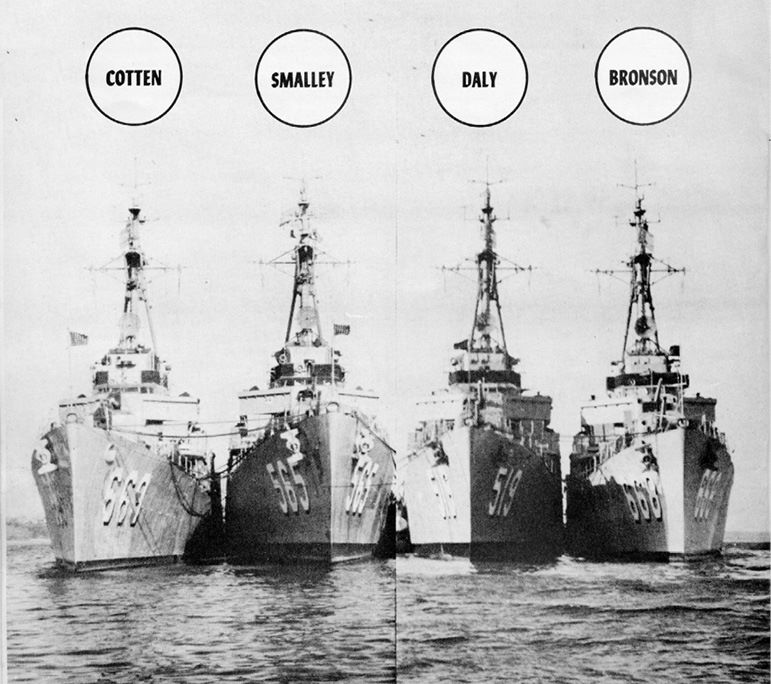
Photo from the Daly’s 1957 Cruise Book. DESDIV (Destroyer Division) 302, consisted of the USS Daly DD 519 ( Flagship ). Flag officer on board. The Daly was also the oldest Fletcher >Class Destroyer (DD). She had the lowest Hull Number in the Atlantic Fleet. The other members were, the USS Smalley DD 565, USS Bronson DD 668, and USS Cotten DD 669, all also Fletcher Class Cans.

DESDIV 302 underway, I took this photo from the starboard side of the fantail (stern) of the Daly. North Atlantic, July 1955
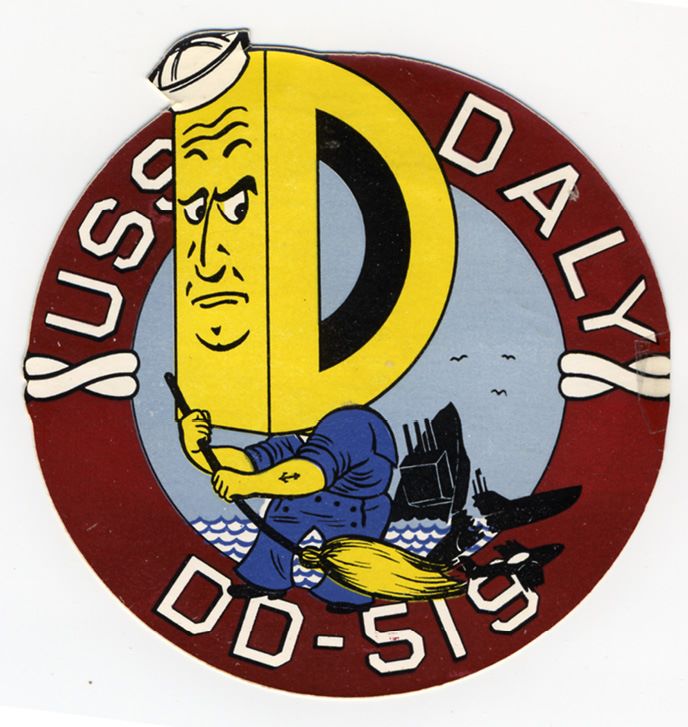
USS Daly’s Ship’s Emblem
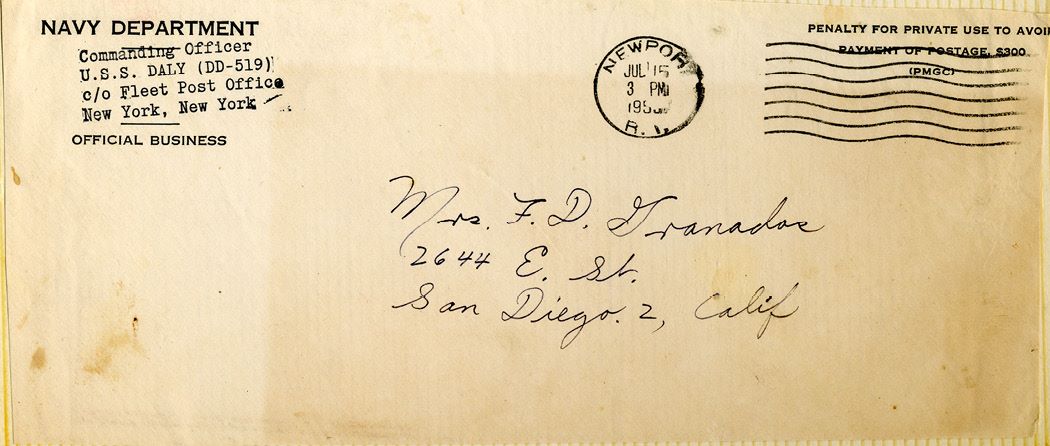
Copy of the envelope of first letter sent to my parents from the Commanding Officer of the USS DALY
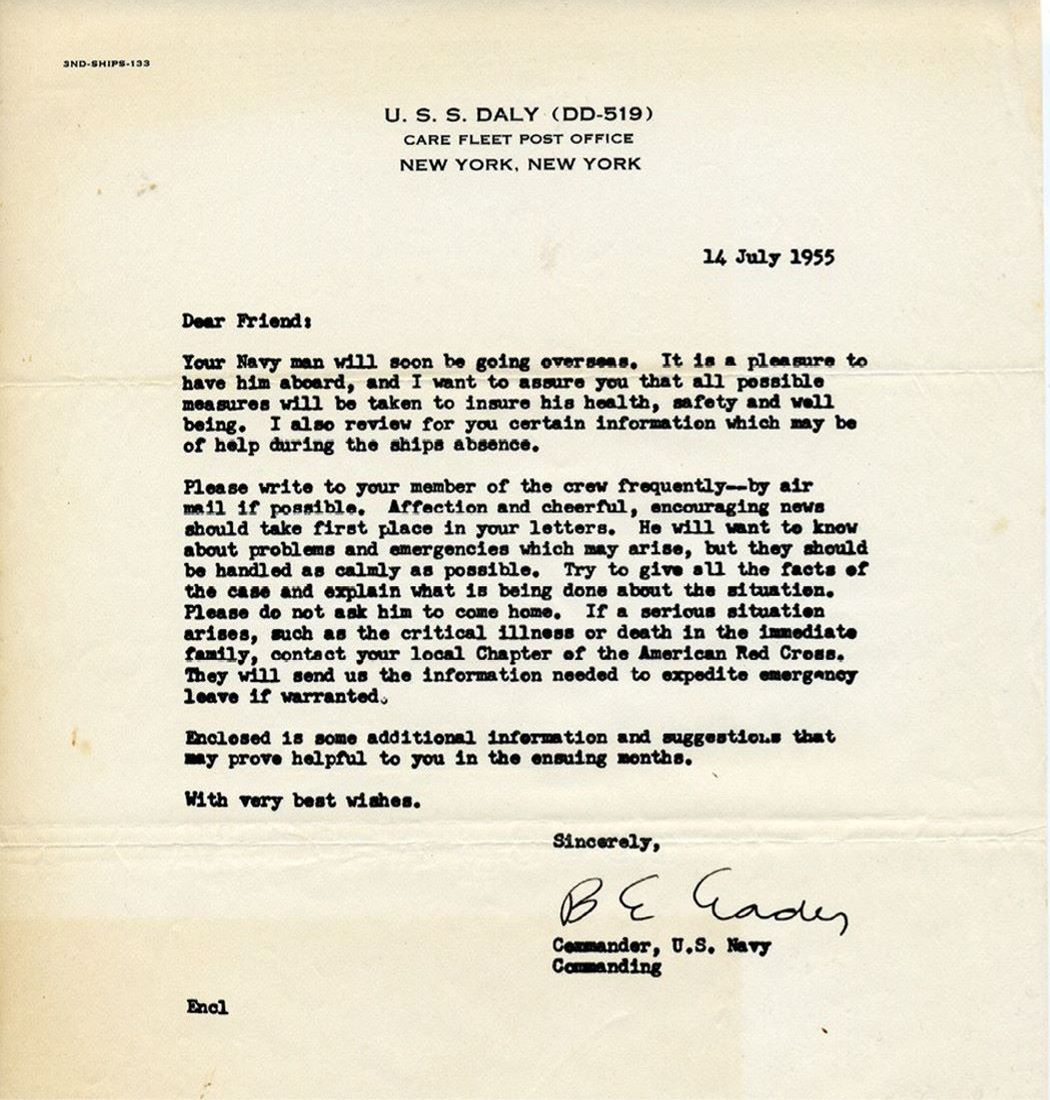
Copy of the first letter sent to my parents from the Commanding Officer of the USS Daly.

USS DALY DD 519, steaming out of Narragansett Bay, Newport, R.I. 1954.
THE BATTLE OF SURIGAO STRAITS
24 OCTOBER 1944
Surigao Straits, is situated just north of the northern tip of the Island of Mindanao in the Philippine Island Group. The USS DALY, was part of DESRON ( Destroyer Squadron ) 24, which consisted of the destroyers BACH DD 470, BEALE DD 471, DALY DD 519, HUTCHINS DD476, and KILLEN DD 593.
The Tin Cans of DESRON 24 were part of Rear Admiral J. B. Olendorf’s Naval force deployed off the Island of Leyte and were deeply involved in the fierce Naval Engagement with the combined Japanese forces of Vice-Admiral Shima’s Fifth Fleet, which consisted of three Cruisers and four Destroyers and Admiral Nishimura’s Southern Force of the Battleships YAMASHARO, FUSO, and the Heavy Cruiser MOGAMI and Destroyers MICHISHIO, ASAGUMO, YAMAGUMO and SHIGURE. The Americans destroyed ten enemy ships, the Victory was made possible in large part by the courage of her "TIN CAN SAILORS "and the accuracy of their torpedoes and guns. The DALY put 3 torpedoes into the Battleship YAMASHARO in a high-speed torpedo attack, and inflicted heavy damage to a Cruiser and a Destroyer, with her 5" guns.
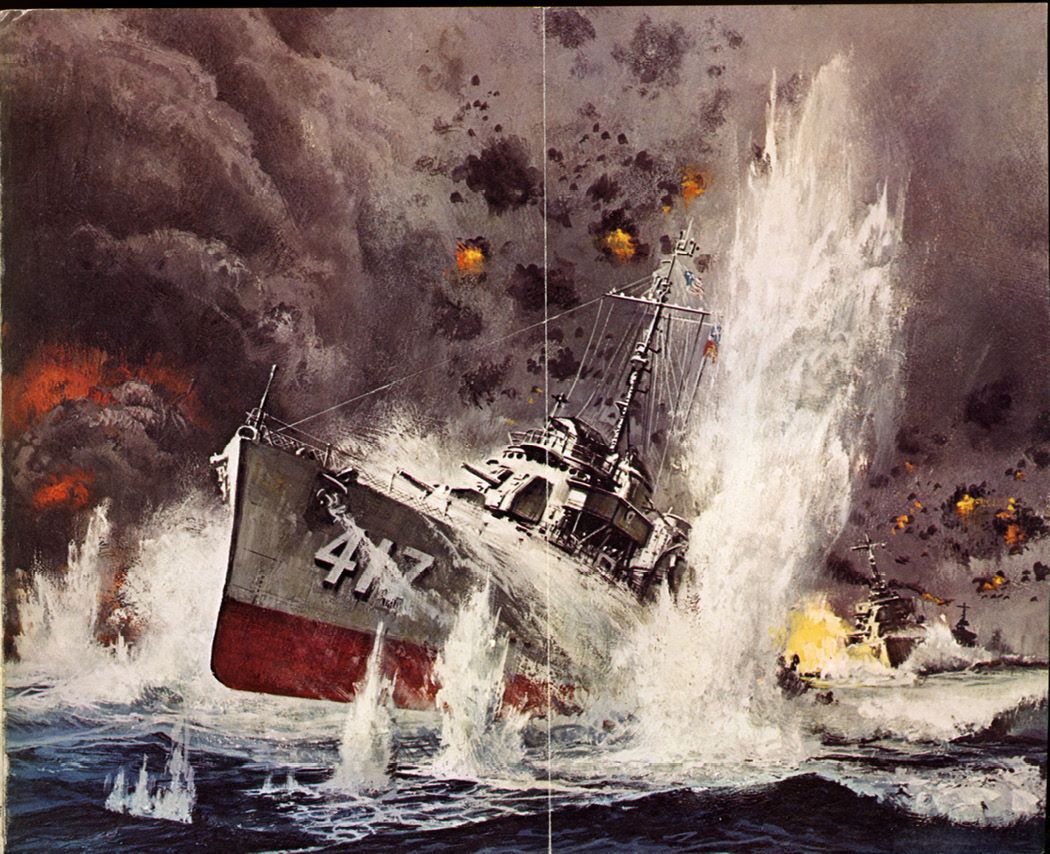
COPY OF PAINTING BY Frank McCarthy. The painting portrays American TIN CANS in a fierce Naval Battle, like that of Surigao Strait.

Map
# 7
Philippines
/ Southeastern China
(Surigao Strait>
1957
Rand Mc Nally World Atlas
BATTLE
OF SURIGAO STRAIT
25
October 1944
Account as it appears in the USS Daly’s 1st Cruise Book ( WWII ) . Provided to me by DALY shipmate Cleo A. Pottorff and from the January – February – March 2002 issue of THE TIN CAN SAILORS
( Published by Tin Can Sailors, The National Association of Destroyer Veterans )
Shortly After sunset on 24 October 1944, the Daly was relieved from her fire support duties, allowing her to rejoin the Naval forces of Vice Admiral Thomas C. Kinkaid’s Seventh Fleet in Leyte Gulf. Rear Admiral J. B. Olendorf, deployed a battle line across the strait’s northern end, a fifteen mile wide stretch of sea between Leyte and Hibuson Island. Thirty nine PT Boats lay in wait in the still waters at the southern end of the strait, to alert the rest of the American force of the enemy’s approach.
The DALY joined the ships of destroyer Squadron 24 ( DESRON 24 ) which included the USS BACHE (DD 470), USS BEALE (DD 471), USS DALY (DD– 519), USS HUTCHINS (DD– 476), USS KILLEN (DD 593) and the HMAS ARUNTA. Three other destroyers of X – RAY Division, the USS CLAXTON (DD 571), USS THORN (DD– 647) and USS WELLES (DD– 628), also joined in with destroyers of DESRON 24. These TIN CANS took up positions at the Western Entrance to Surigao Strait to intercept a strong Japanese surface force that was reported approaching the Southern Entrance to the strait.
The enemy was estimated to have three Battleships, four Heavy Cruisers, four Light Cruisers and ten Destroyers. At 2236 on 24 October 1944, PT 131‘S Radar picked up the Japanese force ( Admiral Nishimura’s Southern Force). PT 131 and two other PT Boats attacked the enemy formation, but were repelled by the Destroyer SHIGURE. Scattered over a fifty- mile course, successive Motor Torpedo Boats ( MTBs ) patrols dodged enemy gunfire and although they attacked repeatedly, they inflicted little damage. They did succeed in breaking up the Japanese formation and alerting the rest of the American Naval force by reporting the enemy’s position, strength and progress.
At 0248, the Daly’s Surface Radar picked up the enemy force. At 0321, the 519 in company of two other TIN CANS of DESRON 24 commenced a High- Speed Torpedo Attack on the heavy units of the enemy force. The Daly’s crew was eager to see what their ship could do against the tremendous odds the ship was heading into. The enemy attempted to illuminate the torpedo attack ( Star Shells ). Their big caliber ( 14", 8", 6" and 5" ) guns opened fire on the three TIN CANS, but their furious efforts to destroy the attacking destroyers did not meet with success.
The Japanese had superior fire power and greatly out numbered the three ship American force. They did not feel threatened and thought the three small ships would turn tail and run, but instead the three American TIN CANS turned toward them and initiated the ensuing NAVAL BATTLE.
Once the Japanese saw what the American Destroyers were up to, the Battleships opened fire with their big caliber (16 inch ) long range guns. Long before the DALY and her two sister destroyers were within good torpedo launching range of the Japanese force. The sailors of the three American TIN CANS pressed home a high speed torpedo attack. The sea began to erupt around the small ships, as the projectiles fired from the Japanese Battleship and Heavy Cruiser began exploding all around them, sending up huge geysers of water.
The Daly and company were ZIG – ZAGING, steaming at FLANK SPEED ( Full Speed ) in a desperate effort to avoid being on the receiving end of one of those big Japanese projectiles. At around 6000 yards out, the Daly was within" HIGH SPEED RANGE" for her Mark ( MK ) 15 Torpedoes. Just before the Daly launched a half salvo ( a 5 torpedo spread ) at their main body, two enemy torpedoes whizzed by, not more than 50 yards ahead.
The Fletcher Class DDs like the Daly carried 10 Mark 15 Torpedoes in two separate Torpedo Tube Mounts, one located between NO. 1 and NO. 2 Smoke stacks and the 2nd, located just aft of NO. 2 smoke stack. The Three TIN CANS continued to press their attack. The ship was then in the most dangerous position it had ever before steamed into, our hearts were in our throats, but all hands were ready to press the attack.
A
LITTLE BIT ABOUT TORPEDO WARFARE IS IN ORDER HERE
(SINCE IT IS MY RATE, I CAN SPEAK WITH SOME ATHORITY ON IT )
When a Destroyer makes a Torpedo Attack, It has to get in fast, launch it’s FISH ( Torpedoes ) and get out. When in Torpedo School, we were trained to be able to launch a spread of five torpedoes within 30 seconds. We were told that the reason for that time, was that in a naval gun battle, when a ship is straddled by enemy gunfire ( one round over one round under ) the third round may be right on target, around 30 seconds after the second round straddles the ship. The object was to get our FISH in the water before we got hit by the third round, if it was on target.
When firing a SPREAD from a Quintuple Torpedo Tube Mount, any number of torpedoes can be selected, from 1 to 5. In a spread, the torpedoes are launched in sequence, one after another, the after most Fish first. Each FISH may have a separate Gyro Setting that controls the torpedoes heading, relative to the ship and the adjacent torpedoes, so that once they are in the water they fan out, much like the fingers on your hand can be spread out in order to cover the greatest area. So the torpedoes cover a larger area of water. This technique allows for the enemy ship to change it’s course and maneuver to try to evade the torpedoes, and still be within the area covered by the spread of torpedoes. The size of the spread ( angle between Fish ) is determined by the size of the target ship, distance to the target and target speed. A Battleship will take a wider spread than a smaller ship like a Cruiser or Destroyer.
Torpedoes were rarely fired at another Destroyer since our 5 inch caliber guns could be used effectively. Another factor is that Destroyers are much more maneuverable than a Battleship or Cruiser and present a much smaller and more difficult to hit target. The 21 inch diameter 24 feet long 3,480 lbs Mark 15 Torpedo, gave the small Destroyer a" Big Punch", and was an equalizer to some degree to the much larger "DREADNOUGHTS" ( Battleships ) big 14, 15 and 16 inch caliber guns, and the 8 inch guns the Cruisers have. Provided of course that the destroyer could get into a good firing distance from the enemy ship.
When going up against a Battleship, that was a very difficult thing to do, since the big guns on the Battleship, had an effective range well beyond 12000 yards, and a good firing range for launching the torpedoes was around 6000 yards. The closer the torpedo is launched from the target, the better the chance of scoring a hit, since the target had less time to successfully evade the torpedoes. But getting in that close was very dangerous and risky business and required high ship speed, superb ship handling ( to evade the enemies guns and even torpedoes ), and a great deal of LUCK. On the fateful day of 24 October 1944, the small American destroyer force exhibited a great amount of all three.
The Daly’s first 5 FISH salvo did not find their mark, as no explosions were witnessed by the Daly’s crew. The Daly repositioned her self to launched her remaining FISH, ( a five torpedo spread ) at an enemy battleship. The Daly’s 2nd torpedo spread, ran" Hot, Straight and Normal" and they were set to run deep, below the Battlewagons protective armor belt, which is anywhere from 12 to 18 inches thick and extends from just above the water line down 16 feet or more, depending on the ships draft in the water. A big ship like a battleship, has a keel depth of well over 30 feet.
This time, many of the Daly’s crew topside were fortunate enough to witness three large explosions and huge geysers of water, as three of the Daly’s five Steam –Fish found their mark, and detonated against the hull of the Battleship.
All her torpedoes expended, the Daly repositioned herself, as she began her 2nd attack. This time with only her main 5" battery, hurling salvo after salvo into two enemy ships.
First, an enemy destroyer absorbed our shells, then the Daly’s Main Battery Director locked in on a 2nd larger target, this time, her blazing 5" guns rained salvos after salvo (as fast as the men could load the 60 pound projectile and brass case full of powder) down on a Heavy –Cruiser, catching her completely by surprise. The accurately aimed salvos ripped through her steel deck and exploded in her magazine, setting her ablaze and dead in the water.
The Daly, then turned and hightail it out of Harms –Way, at Flank Speed. As the three American Destroyers steamed away, the Japanese 9 ship force was scattered and the Battleship was dead in the water and a Heavy Cruiser and a Destroyer were on fire, taking on water ( sinking ) and out of action.
Although the Daly’s torpedoes did not immediately sink the battleship, her torpedoes had inflicted heavy damage to her, making it impossible for her to escape. The battleship, was an easy target for our heavy units to finish off. It was later learned that the Daly’s torpedoes had indeed struck the Japanese Battleship YAMASHARO.
The Naval Engagement in which the American TIN CANS performed so courageously, later became known as" THE BATTLE OF SURIGAO STRAITS". The Daly’s crew proudly painted on the ships Bridge, 3 black ship silhouettes with the Japanese Rising –Sun in color, for the Battleship, the Heavy Cruiser and a Destroyer. Black silhouettes of 10 Japanese aircraft destroyed and 23 Shore Bombardments, to her credit.

Photo of War Record painted on the side of the Daly’s Bridge. From a copy of the first USS DALY Cruise Book ( WW II ). October 1944
Go back to to Chapter 6: TORPEDO SCHOOL, CLASS A, NEWPORT, RHODE ISLAND 4 October 1954 – 13 May 1955
Continue to Chapter 8: LIFE ABOARD A TIN CAN, MAY 1955